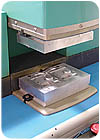
What do a car, a refrigerator, a submarine and a child's portable video game have in common?
For one, each contains electrical and electronic assemblies that are essential to its functioning. In addition, each is exposed to a variety of environmental rigors that can damage those assemblies, causing inconvenient and even dangerous problems.
Water, dust, oil, chemicals, extreme temperatures and intense jostling can damage circuitry and cause malfunctions. To prevent that from happening, electronics assemblers have several options to safeguard sensitive circuitry.
The two most common methods of protecting electrical and electronic assemblies are potting and conformal coating. In potting, the assembly is placed inside a cavity or housing. Liquid epoxy or urethane is then poured over the assembly, filling the cavity. In conformal coating, a dielectric material is painted or sprayed onto the surface of an electronic assembly. Common coatings include silicone, acrylic, urethane, epoxy and Parylene.
However, these methods can be costly and wasteful, and ultimately, they may not provide long-term protection. Potting compounds and conformal coatings often require long cure times, and they can emit harmful fumes while curing. When these processes are applied to particularly small assemblies, the amount of wasted material is often greater than the material that's actually applied to the product. In some cases, the wasted material costs more than the finished assembly.
An alternative to these processes is low-pressure injection overmolding. Initially developed for the European automotive industry in the late 1980s, low-pressure injection overmolding protects electrical and electronic assemblies by encasing them with a molten thermoplastic material. The assembly is placed in a mold, and the material, a nonconductive hot-melt polyamide, is injected into the cavity under low pressure. After a short cooling period, the assembly is released from the mold encased in a plastic shell that is impervious to the elements.
The Process
The hot-melt material can be specially formulated to meet a variety of application requirements. The material can be transparent or opaque, and it can be formulated in a variety of colors. It resists flame, impacts and vibration. As a hot-melt, the material is supplied in the form of small plastic beads or flakes. It does not require mixing. No chemical reactions take place during application, and the material does not release solvents or toxic fumes as it cures. As an added benefit for the ecologically conscious, the polyamide can be produced from renewable raw materials.The hot-melt cures in seconds at room temperature, so there's no need to wait between the application of the material and the next step in the assembly process. It adheres well to most substrates, including PVC-coated wires and flexible circuit boards.
The molds for low-pressure injection overmolding can be made from aluminum or steel. Aluminum molds transfer heat well for short cycle times, but steel can be used if durability is a concern for long production runs.
The process begins by melting the thermoplastic material in a tank at 370 to 450 F-the same temperature at which you would grill a steak. Then, the molten material is fed by a gear pump or rod system to an injector head, which pressurizes the material from 20 to 200 psi. (For safety and precision, the pressure is typically regulated by a bypass.) A nozzle, located at the injector head, is opened and closed by a timer, allowing the thermoplastic to flow into the mold and envelop the assembly.
Most application pressures range from 80 to 100 psi. However, the low viscosity of the molten thermoplastic-1,000 to 10,000 centipoise-makes it possible to mold fragile electronic components at pressures as low as 20 psi. Such components could be easily damaged by the high pressures involved in standard injection molding.
Compared with traditional encapsulation methods, the waste produced by the low-pressure overmolding process is miniscule, since purging is kept to a minimum. The process eliminates the need to put the assembly in a case or shell, and engineers can even add legs or grommets to the finished product for attachment purposes.
The entire process, including injection and cooling time, takes less than 60 seconds for approximately 90 percent of all applications. In contrast, epoxy potting compounds can take up to 24 hours to fully cure.
Low-pressure injection overmolding creates an impervious barrier between electrical and electronic assemblies and the environment. The material will maintain its functional integrity in temperatures ranging from -40 F to 320 F. The plastic cannot be penetrated by water or dust, and it is highly resistant to most chemicals and hydraulic fluids. The hardness of the material protects the assembly from aggressive vibration. And, because the thermoplastic is an electrical insulator, the molding also protects the circuitry from electrostatic discharge, in some cases eliminating the need for anti-static packing materials.
Once an electronic assembly is protected by the overmolded material, it will still work even if it is submerged in water, oil or transmission fluid; shaken or dropped; and exposed to static shock.
Low-pressure injection overmolding can be used to protect sensors, motors, switches, fiber-optic components, connectors, circuit boards, relays, electrical components and fuel cells. It is ideal for temperature-sensitive parts or parts with complex shapes. The process is currently being used by the automotive, electronics, appliance, marine, medical and telecommunications industries.
For more information, call TEMS at 248-655-2535, visitwww.temsnd.com, oreInquiry 20.